
Environmental Biotechnology - Jordening and Winter
.pdf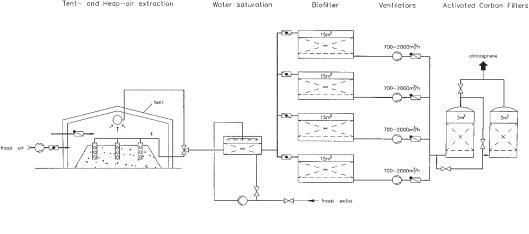
10.4 Efficiency and Economy 283
Fig. 10.6 Schematic representation of soil air extraction from heaps.
ature reaches levels of about 60 °C. By turning the soil, aerobic conditions appear for a short time so that TAT is bound to the soil matrix and cannot be detected after treatment. With this technology, the treatment time can be reduced to less than four weeks to achieve target values (Fig. 10.7). The concentration of PAH is also reduced in the heaps. This example shows that the heap technology can be used for thermophilic degradation processes and that, under thermophilic conditions, degradation times can be reduced significantly.
Efficiency has to be discussed in relation to the economics of the process. Because of the low investment costs for installation and the simple operation procedures, the heap technique is of course a low-cost technology compared with other biological technologies like bioreactors or soil washing and incineration. Therefore, about 80% of the soil treatment plants installed in Germany are biological treatment plants (Schmitz and Andel, 1997), most of them working with the heap technique. However, because of the high number of treatment plants in Germany, with an annual capacity of about 2 500 000 t the competition is extremely strong. During the last decade prices for soil remediation have decreased from nearly 100 US$ per ton to 30–50 US$ per ton. Even for the simple heap technique, this is the absolutely lowest limit for any reliable operation.
On the other hand, legislative regulations regarding soil handling and plant operation have become stricter, so that nearly half the costs for soil bioremediation by the heap technique are due to measures set by the authorities. In contrast to this high level of environmental-safety and health-care concerns regarding treatment plants that destroy contaminants and lead to recycling of soil for different uses, dumping contaminated soil and leaving the problem for the next generation is still allowed.
Nevertheless, soil treatment by the heap technique is suitable for many different situations involving contaminants, soil quality, or climatic conditions. It is adjustable by technical modifications to meet any requirement of the degradation process. Therefore, although it was the first large-scale remediation technique, it still needs further development to become the biological treatment technology of the future.
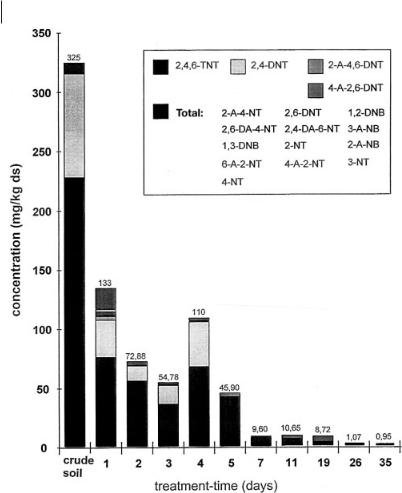
284 10 Bioremediation by the Heap Technique
Fig. 10.7 Time course of TNT degradation.
References
Altmann, B. R. et al., DGMK Forschungsbericht 396-02 – Erfahrungsbericht über die biologische Ex-situ-Sanierung ölverunreinigter Böden. Hamburg 1988: DGMK.
Cookson, J. T. Jr., Bioremediation Engineering: Design and Application. New York 1995: McGraw-Hill.
Dechema, Labormethoden zur Beurteilung der biologischen Bodensanierung. Frankfurt/ Main 1992: Dechema.
Dott, W., Becker, P. M., Functional analysis of communities of aerobic heterotrophic
bacteria from hydrocarbon-contaminated soils, Microb. Ecol. 1995, 30, 285–296.
Ewers, J., Freier-Schröder, D., Knackmuss, H.- J., Selection of trichloroethene (TCE) degrading bacteria that resist inactivation by TCE,
Arch. Microbiol. 1990, 154, 410–413. Feitkenhauer, H., Biodegradation of Aliphatic
and Aromatic Hydrocarbons at High Temperatures: Kinetics and Applications, Thesis, Technical University Hamburg, Harburg 1998.
Henke, G. A., Experience reports about on-site bioremediation of oil-polluted soils, in: Recy-

cling International (Thomé-Kozmiensky, K. J., ed.), pp. 2178–2183. Berlin 1989: EF-Ver- lag.
Hupe, K., Koning, M., Lemke, A., Lüth, J.-C., Stegmann, R., Steigerung der Reinigungsleistung bei MKW durch die Zugabe von Kompost, TerraTech 1998, 1, 49–52.
Koning, M., Brauckmeier, J., Lüth, J.-C., Ruiz-Saucedo, U., Stegmann, R. et al., Optimization of the biological treatment of TPH-contaminated soils in biopiles, Proc. 5th Int. Symp. In Situ and On Site Bioremediation, San Diego, CA 1999.
Koziollek, P., Bryniok, D., Knackmuss, H.-J., Ethene as an auxiliary substrate for co-oxida- tion of cis-1,2-dichloroethene and vinyl chloride, Arch. Microbiol. 1999, 172, 240–246.
Krass, J. D., Mathes, K., Schulz-Berendt, V., Scale up of biological remediation processes: evaluating the quality of laboratory derived prognoses for the degradation of petroleum hydrocarbons in clumps, in: Proc. SECOTOX 99, 5th Eur. Conf. Ecotoxicol. Environ. Safety (Kettrup, A., Schramm, K.- W., eds.). March 15–17, 1998, Munich
1998.
References 285
Lenke, H., Warrelmann, J., Daun, G., Walter, U., Sieglen, U., Knackmuss, H.-J., Bioremediation of TNT contaminated soil by an anaerobic/aerobic process, in: In situ and Onsite Bioremediation Vol. 2 (Alleman, B. C., Leeson, A., Eds.), pp. 1–2. Columbus, OH 1997: Battelle Press.
Meyer, O., Refae, R. I., Warrelmann, J., Reis, H. von, Development of techniques for the bioremediation of soil, air and groundwater polluted with chlorinated hydrocarbons: the demonstration project at the model site in Eppelheim, Microb. Releases 1993, 2, 2–11.
Schmitz, H.-J., Andel, P., Die Jagd nach dem Boden wird härter, TerraTech 1997, 5, 17–31.
Schulz-Berendt, V., Biologische Bodensanierung: Praxis und Defizite, in: Bödenökologie: interdisziplinäre Aspekte (Köhler, H., Mathes, K., Breckling, B., eds.), Berlin 1999: Springer-Verlag.
Sorkoh, N. A., Ibrahim, A. S., Ghanoum, M. A., Radwan, S. S., High-temperature hydrocarbon degradation by Bacillus stearothermophilus from oil polluted Kuwait desert,
Appl. Microbiol. Biotechnol. 1993, 39, 123–126.

287
11 Bioreactors
René H. Kleijntjens and Karel Ch. A. M. Luyben
11.1 Introduction
11.1.1
Contaminated Solid Waste Streams (Soils, Sediments, and Sludges)
Waste recycling plays a key role in the development of a sustainable economy (Suzuki, 1992). The classical approach, remediation without the production of recycled materials, does not contribute to durable material flows. Moreover, the production of reusable materials is a necessity to make waste treatment an attractive economic solution. Recycling, however, cannot be done without regard to the effort and costs needed. The overall environmental benefits should be positive and fit within the local economic and legal framework.
A practical way to qualify these benefits is found in three issues:
•the quality of the recycled products
•the amount of energy required per ton
•the cost per ton
Solid waste streams (contaminated soils, sediments, and sludges) can be recycled. The solids have to be transformed into usable products while the contaminants are removed or destroyed. If the contaminants are organic (such as mineral oil, PAH, solvents, BTEX, PCB), the use of bioreactors can result in environmental benefits (Riser-Roberts, 1998). In bioreactors populations of soil organisms degrade the contaminants to yield carbon dioxide, water, and harmless byproducts (Schlegel, 1986).
A prerequisite for the implementation of new technologies such as bioprocessing is the definition of the goals of recycling and treatment. In the Netherlands legal targets for recycled materials were set in the Dutch building materials law (Building Material Act, 1995). Depending on the content and the leaching of components, two different ways for using recycled materials in plants are defined:
•category 1 products, needing no further isolation
•category 2 products, needing further isolation and monitoring
Environmental Biotechnology. Concepts and Applications. Edited by H.-J. Jördening and J. Winter Copyright © 2005 WILEY-VCH Verlag GmbH & Co. KGaA, Weinheim
ISBN: 3-527-30585-8
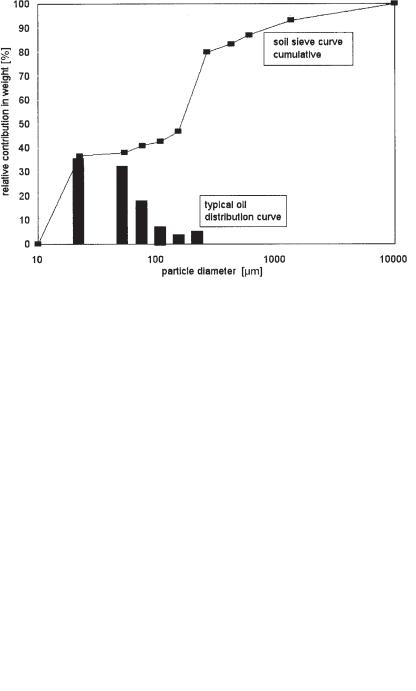
288 11 Bioreactors
In the Dutch practice, treatment processes are aimed at the production of category 1 recycled products. Although each country still has its own standards, and standardization is far away (Northcliff et al., 1998), it is clear that practical recycling standards accelerate the development needed to create sustainable technologies.
11.1.2
Characteristics of Contaminated Solids
In soils the solid matrix is frequently dominated by sand, while the water content may be <25%; various levels of debris can be found depending on the history of the site, but rarely exceed 10%. River, harbor, and canal sediments contain mostly water (frequently >60% to 70%), while the fine fraction (<63 µm) dominates the solids if dredging takes place in the upper sediment layers. Industrial and municipal sludges are mostly very moist (>95% water) and have a large content of organics (>60%) (INES, 1997). Industrial sludges mostly originate directly from corrosion and wear from equipment or water treatment units on the site.
Disregarding the heterogeneous nature of the waste, the contaminant behavior is largely determined by the fines (Werther and Wilichowski, 1990), because submicron particles such as humic–clay structures and clay agglomerates have an extremely high adsorption capacity (Brady, 1984). The solid waste, therefore, basically contains a contaminated fine fraction, a less contaminated sand–gravel fraction, cleaner debris, and a contaminated water phase.
Fig. 11.1 Distribution of contaminants over the solids fractions (in percentage of the total amount of oil present) and particle size distribution (cumulative).

11.2 Bioreactors 289
In Figure 11.1 the line shows a typical particle size distribution for soils having a dominant fraction of fines (the step between 10 and 20 µm) and a dominant sand fraction (the step between 150 and 250 µm).
The bars show the measured mineral oil concentration as distributed over the fractions. For efficient processing of this waste, only the fractions <150–200 µm should be treated.
In general one can state that, to develop an appropriate recycling technology, the particle features of the solids have to match the type of process operation. For bioprocessing this implies integration of the separation technology and bioreactors in a sequence of operation in which the clean fractions are removed from the feed before entering the reactor (Kleijntjens et al., 1999).
11.2 Bioreactors
11.2.1
Reactor Configurations
The aerated bioreactor for solids processing is a three-phase (solid–liquid–gas) multiphase system. The solid phase contains the adsorbed contaminants, the liquid phase (process water) provides the medium for microbial growth, and aeration complicates the system. Nutrients and adapted biomass may be added to enhance breakdown. Furthermore, processing conditions (temperature, pH, O2 level, etc.) can be monitored and to some extent controlled.
Regarding the bioreactor configuration there are two major topics:
•physical state of the multiphase system
–bioreactors with a restricted solids holdup: slurry reactors (typical solids holdup <40 wt%)
–bioreactor with restricted humidity: solid-state fermentation (solids content >50 wt%)
•operation mode
–batch operation: no fresh material is introduced to the bioreactor during processing; the composition of the content changes continuously
–continuous operation (plug flow): fresh material is introduced and treated material removed during processing, the composition in the reactor remains unchanged with time (Levenspiel, 1972); in practice, semicontinuous operation is often used (batch-wise feeding and removal giving small fluctuations in the reactor)
Three basic reactor configurations exist:
•slurry bioreactors
•solid-state fixed-bed bioreactors
•rotating-drum dry solid bioreactors
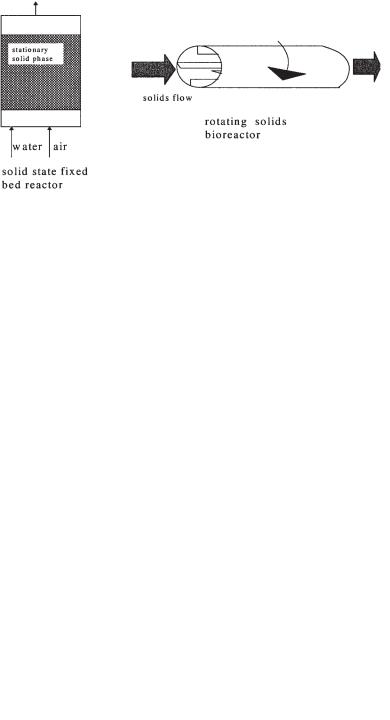
290 11 Bioreactors
Characteristic of all types of slurry bioreactors (Fig. 11.2) is the need for energy input to sustain a three-phase system in which the solid particles are suspended; the force of gravity acting on the solids has to be compensated for by the drag forces executed by the liquid motion (Hinze, 1959). In a properly designed slurry system, the energy input is used to establish three phenomena:
•suspension
•aeration
•mixing
A slurry bioreactor can work properly only if these three measures are balanced. For each reactor configuration, the appropriate processing conditions depend on parameters such as the reactor scale, particle size distribution, slurry density, slurry viscosity, oxygen demand of the biomass, and the solids holdup (Kleijntjens, 1991).
For solid-state fermentations there is no need to maintain a solids–liquid suspension; a compact, moist, solid phase determines the system. Both the fixed-bed reactor and the rotating-drum bioreactor are suited to solid-state fermentation (Fig. 11.3). In
Fig. 11.2 Common configurations for slurry bioreactors.
Fig. 11.3 Bioreactors for solid-state processing: (a) fixed-bed reactor, (b) rotating-drum reactor.
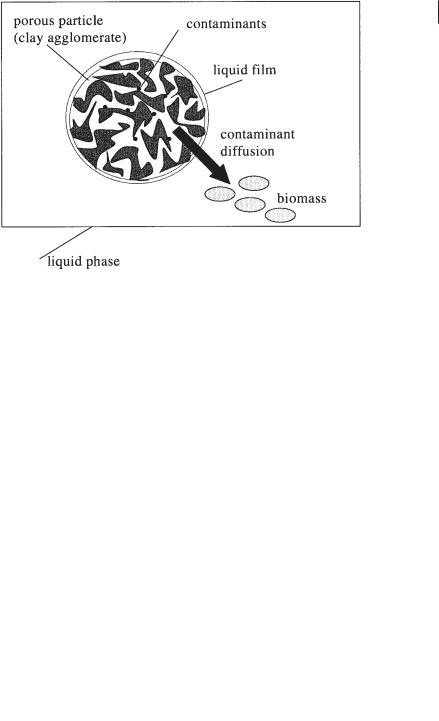
11.2 Bioreactors 291
the fixed-bed reactor the contaminated solids rest on a drained bottom as a stationary phase. Forced aeration and the supply of water are mostly applied as a continuous phase (Riser-Roberts, 1998). Fixed-bed reactors are mostly batch operated. Although landfarming might be considered a form of solid-state batch treatment under fixed-bed conditions (Harmsen, 1991), this technique offers limited control options (in comparison to other solid-state treatment) and is therefore not considered to be a bioreactor within the present context.
Continuous solid-state processing is possible in the rotating system. Here, the solid phase (as a compact moist material) is ‘screwed and pushed’ through the reactor. In line with slurry processing, energy is required to transport the solids through the system.
11.2.2
Diffusion of Contaminants out of Solid Particles
Regardless of the bioreactor type, the presence of sufficient water is crucial. Not only is a water activity around 100% a necessity for microbial action (van Balen, 1991), but biodegradation fully depends on the availability of the components in the water phase. On the microlevel, diffusion of the adsorbed contaminants into the bulk phase is the rate-determining step (Fig. 11.4). Mathematical models focus on capturing of the different physical processes into single diffusion parameters (Wu and Geschwend, 1988). The overall diffusion process depends also on the flow conditions around the particles (Crank, 1975).
An illustration of the importance of the flow around the particles was given by Koning et al. (1998), who analyzed microbial breakdown of a petroleum-contaminat-
Fig. 11.4 Diffusion of contaminants.

292 11 Bioreactors
ed soil. A conversion level of 80% was reached within about 10 d in a slurry reactor, but under fixed-bed conditions some 150 d were required to reach the same conversion level. They concluded that “the enhanced breakdown is based on an increasing bioavailability of the contaminant due to suspending of and the mechanical strain on the soil material in the slurry reactors”. In another slurry experiment, it was shown that manipulation of reactor parameters such as the energy input result in faster breakdown (Reynaarts et al., 1990).
The reactor type, scale, energy input, and aeration rate each have an impact on the diffusion. The better these parameters can be optimized, the faster the breakdown proceeds.
Having established proper diffusion conditions, the presence of adapted biomass capable of degrading the desorbed contaminants is essential. Organisms that are already present in the waste are almost always the most practical source of adapted biomass.
Of the three different bioreactors, the slurry system offers the best features to substantially influence the diffusion rate. Intense multiphase mixing allows for the exchange of desorbed contaminants, nutrients, and biomass through the medium. In addition, particle deagglomeration has been measured (Oostenbrink et al., 1995); this results in smaller particles and a faster diffusion rate (smaller particles mean shorter diffusion distances).
For solid-state processes in fixed-bed reactors there are fewer factors to influence the microenvironment of the pollution. Only air and liquid (nutrients) can be forced into the system while the solids are packed. On the microlevel, the rotating solids bioreactor is intermediate between the fixed-bed and slurry systems, and deagglomeration of the moist mass and phase exchange can take place.
11.3
Slurry Bioreactors
11.3.1
Slurry Processing
A slurry bioreactor functions only with a pretreated feedstock; therefore, the bioreactor is necessarily integrated with washing–separation operations and includes a dewatering operation at the end of the process (Kleijntjens, 1991; Robra et al., 1998).
A typical setup of an integrated (slurry) bioprocess is shown in Figure 11.5. First, the feedstock is screened using a wet vibrating screen to remove the debris (typical size >2–6 mm). Second, sand fractions are removed by one or more separation techniques such as sieves, hydrocyclones, Humphrey spirals, flotation cells, jigs, and upflow columns; a typical separation diameter (the so-called cutpoint) for the hydrocyclone depicted is 63 µm (Cullinane et al., 1990). In the cyclone the slurry flow is split into a sand fraction (particle size >63 µm) at the bottom and a fine fraction at the top (<63 µm).
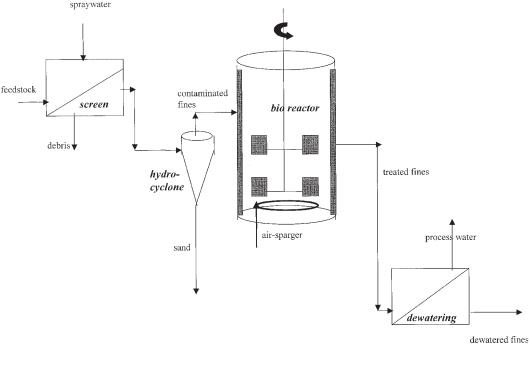
11.3 Slurry Bioreactors 293
Fig. 11.5 Typical setup for a slurry bioprocess using a batch-operated aerated stirred-tank reactor (typical solids holdup is 20 wt%).
The top flow of the cyclone, containing the contaminated fines, is fed to the bioreactor (a stirred tank is shown, but any of the three types in Figure 11.2 can be chosen). The final operation results in a dewatered product containing the fines and a flow of process water.
11.3.2
Batch Operation
A slurry bioreactor is often designed as a standard continuously stirred tank reactor (CSTR) having a mechanical stirrer, baffles, and a sparger at the bottom (Fig. 11.5). In the system a three-phase suspension of contaminated solids, water, and air is maintained. Batch degradation experiments in aerated, stirred, slurry bioreactors have been carried out frequently.
Figure 11.6a shows the experimental results from a batch experiment on a 4-L scale. Using a conventional stirred bioreactor with baffles (stirrer speed 600 rpm, aeration rate 1.5–3 L min–1, temperature kept at 30 °C), adapted biomass and nutrients were added (ammonium, phosphate, and potassium) while the pH was kept at 7–8. The soil was an oil-contaminated sandy soil having an initial oil concentration
